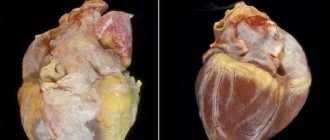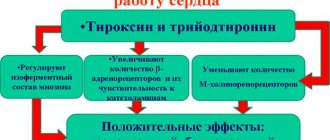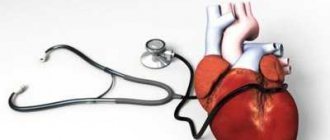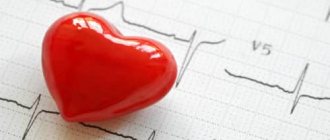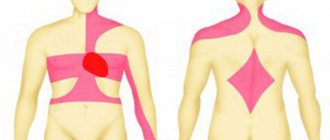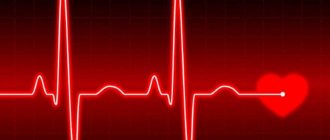Everything in the human body is interconnected, so one disease often contributes to the development of another. If necessary, during treatment, all pathologies present in the patient, including the gastrointestinal tract and heart, are taken into account. Sometimes improving the course of the main disease allows you to reduce the clinical signs of another.
Disease (from Latin morbus) is a disruption in the functioning of individual parts of the body or the entire organism as a whole. During illness, homeostasis is disrupted, normal life activity changes, and sometimes there is a danger to life itself.
The synonym for illness is disease, and the antonym is health.
The disease can be acute or chronic, affecting various organs and systems of the body. The disease is often transmitted by heredity, but the lifestyle that the patient leads plays an important role. Since some diseases develop against the background of other pathological conditions, a combination of gastrointestinal and cardiac disorders is often observed.
Video: Human digestive system. Marvelous!
Connection of organs and systems in the human body
The human body contains trillions of cells, 78 different organs and almost 100,000 km of blood vessels when stretched to their full length.
Each organ belongs to one of ten body systems, which are interconnected and dependent on each other, allowing them to function in harmony. For example, the heart does not beat if the brain and nervous system do not send signals about it. The skeletal system relies on nutrients obtained from the digestive system to build strong, healthy bones.
Stylized anatomy diagram of the human body: skeletal, muscular, cardiovascular, nervous and digestive systems.
There are 10 systems:
- Cardiovascular
- Respiratory
- Nervous
- Muscular
- Skeletal
- Digestive
- Endocrine (hormonal)
- Lymphatic or immune system
- Reproductive
- Integumentary (skin, hair)
Each body system is a group of parts that work together. The cardiovascular system works to circulate blood, while the respiratory system helps bring oxygen into the body.
Every single system in the body interacts with other systems in the body. The blood circulation is a good example of how systems interact with each other. The heart is a pump. As blood circulates through the digestive system, it becomes saturated with nutrients. The blood also contains oxygen, which is inhaled by the lungs. The circulatory system supplies oxygen and nutrients to other parts of the body, and from there it takes cellular waste products, including carbon dioxide, and carries these wastes to the kidneys and lungs for elimination outside the body. The circulatory system also distributes hormones from the endocrine and immune systems throughout the body.
Each system depends on the normal operation of the others.
- The respiratory system relies on the circulatory system, which delivers oxygen to all tissues, including cardiomyocytes.
- The bones of the skull and spine protect the brain and spinal cord, but at the same time the brain regulates the position of the skeleton and controls the function of the muscles.
- The circulatory system supplies the brain with blood and creates the necessary blood pressure, while with the help of nerve impulses vascular tone and heart rate are regulated.
Seemingly unrelated systems are connected. The skeletal system relies on the urinary system to remove waste products created by bone cells. In turn, the bones of the skeleton form a frame that protects the bladder and other internal organs. The circulatory system delivers oxygenated blood to the bones. Meanwhile, bones are involved in the creation of new blood cells.
Working together, all of the body's systems maintain internal stability and balance, otherwise known as homeostasis .
A disease in one system of the body can disrupt homeostasis and cause problems in other systems. If, for example, you become ill with the AIDS virus, then pneumonia, that is, pneumonia, may develop. A yeast infection in the reproductive system, Candida, affects the esophagus and digestive system or causes skin cancer known as Kaposi's sarcoma.
Pulse with gastritis
Pulse surges during gastritis are not related to each other; these are different diseases that cannot lead to each other. Pulse surges during gastritis are usually not a symptom of disease (except perhaps diabetes), so it cannot be said that it can provoke gastritis.
Why can the pulse increase with gastritis?
There are many reasons for the acceleration of the pulse during gastritis, most of which are temporary, although some reasons can significantly threaten human health and require immediate medical intervention and treatment.
Pulse surges during gastritis are not related to each other; these are different diseases that cannot lead to each other
One of the reasons for a high pulse may be problems with the heart and blood vessels, such as hypertension, coronary heart disease, pericarditis and other pathologies. Also, atherosclerosis of the artery walls and impaired elasticity can contribute to an increase in heart rate.
Other causes of high heart rate with gastritis may be disturbances in the functioning of the thyroid gland, since it is the gland that regulates metabolism in the body. Typically, a high heart rate is caused by an increase in thyroid activity. Pathologies of the heart valves, alcohol consumption, emphysema, and metabolic disorders can also lead to increased heart rate.
Temporary causes of pulse disturbances during gastritis can be the use of psychostimulants, smoking, rich fatty foods, stress, fear, nervousness, taking medications, fever, anemia and vitamin deficiency, dehydration, toxicosis. When these factors are eliminated, the pulse quickly returns to normal. Also, an accelerated heart rate can occur during pregnancy.
Why can the pulse decrease with gastritis?
Low heart rate is a condition characterized by a decrease in heart rate below 60 beats per minute. A low pulse with gastritis is not a normal condition, so you need to undergo an examination and identify the cause.
A low pulse with gastritis is not a normal condition, so you need to undergo an examination and identify the cause
Low heart rate is medically called bradycardia. A rare heart rate (50-60 beats, sometimes less) can be caused by a number of problems. If a decrease in heart rate is caused by pathology, then such a signal from the body cannot be ignored. Sometimes this can result in dangerous consequences for humans.
A constantly low pulse and low blood pressure during gastritis indicate the development of hypotension, a complication of which may be deterioration in the functioning of internal organs and the brain. But in the case when the pulse decreases and the pressure is normal, it is worth determining the root causes of this condition. Bradycardia can develop due to digestive problems, sleep problems, or when there is a high level of potassium in the blood.
A decrease in heart rate with gastritis can be caused by completely harmless reasons:
- sleep: during rest, all processes in the human body slow down, including heart rate;
- exposure to the cold: the lower the ambient temperature, the lower the pulse, but now we are not talking about frostbite. This is a kind of protective reaction of the body;
- hormonal changes in adolescents and pregnant women;
- in older people, metabolism slows down, vascular tone is disturbed, which also provokes a weak heartbeat;
- Professional sports lead to myocardial hypertrophy; therefore, pumping a large volume of blood does not require a large number of contractions.
Moderate bradycardia is not dangerous; there are people who feel great with a pulse of 50 beats per minute. This applies mostly to athletes. If bradycardia is caused by endocrine disorders or diseases of the heart muscle, it is important to undergo comprehensive treatment.
The connection between the gastrointestinal tract and heart disease
Recently, researchers have scientifically confirmed the connection between the heart and the human digestive system. The findings could forever change the way patients with heart disease are treated.
Cleveland clinical researchers have found that SIBO is often associated with coronary artery disease (CAD). Research into this issue has shown that many patients who have one of these health problems also have the other.
Patients with SIBO experience a number of side effects, including bloating and abdominal discomfort.
Flora found in the digestive system has always been a focus of research, mainly because gut health problems often indicate inflammation elsewhere in the body. However, until now, scientists have not focused on the connection between gut and heart health.
Heart disease is the leading cause of death worldwide
Heart disease is the leading cause of death among both men and women in the United States and other countries around the world. About 11% of the American population suffers from coronary heart disease, and another 20% of the population has an overgrowth of small intestinal bacteria.
Researchers cannot yet say whether SIBO causes CAD or CAD contributes to the development of SIBO, but identifying the correlation between the two has already proven extremely important.
Metabolism may be wrong
Clinical researchers believe that metabolic processes associated with digestion may greatly influence the development of coronary artery disease.
“We don't really know the order of cause and effect, which makes the study even more interesting,” explains gastroenterologist Dr. Bo Shen. “We believe there is a poorly understood gut-heart connection in which a bidirectional relationship is at work.”
“It is believed that gut bacteria may cause obesity,” Dr. Shen added. “SIBO has been determined to be more common in morbidly obese patients, and we don't know whether this is a cause or an effect.”
In addition to obesity, SIBO has also been linked to diabetes and non-alcoholic fatty liver disease.
Tachycardia
A healthy person does not feel the work of his heart in any way. And if heart rhythm disturbances occur, he may feel palpitations, interruptions or “loss of pulse.” The normal heart rate of an adult is from 60 to 90 beats per minute.
Tachycardia is an increase in heart rate to values exceeding 90 beats per minute. Often in such situations, patients complain of increased beating, “fluttering” or “jumping out” of the heart, they say that “the heart is pounding.” Of course, such a condition is a deviation from the norm.
Causes of tachycardia:
Heart diseases
Diseases of the heart and blood vessels that can provoke tachycardia include:
- heart failure;
- coronary heart disease, myocardial infarction;
- aortic insufficiency;
- abnormalities of the cardiac conduction pathways;
- heart rhythm disturbances;
- arterial hypertension.
Other (non-cardiac) causes of tachycardia
:
- respiratory failure, emphysema;
- obesity;
- binge eating;
- alcohol abuse;
- excessive consumption of strong coffee, tea;
- use of narcotic and psychotropic drugs;
- diabetes;
- increased thyroid function;
- pheochromocytoma;
- vegetative-vascular dystonia;
- panic attacks.
Associated symptoms
Tachycardia may be accompanied by:
- nausea;
- cold sweat;
- dizziness;
- shortness of breath;
- pain in the chest, a feeling of squeezing;
- weakness;
- loss of consciousness;
- frequent yawning;
- anxiety, etc.
Tachycardia in heart disease
described in the sections on heart failure, myocardial infarction, aortic insufficiency, cardiac rhythm and conduction disorders, and arterial hypertension.
Other causes of tachycardia are briefly listed below.
Tachycardia and diabetes mellitus
Tachycardia is one of the manifestations of decompensation of diabetes mellitus. Disturbances in the nervous regulation of the heart often lead to increased heart rate, which is difficult to treat.
Tachycardia in diseases of the stomach
In some cases, tachycardia after eating is caused by the so-called gastrocardial syndrome. It is characterized by the fact that spicy or fatty foods lead to exacerbation of stomach pathologies, manifested by pain in the abdominal cavity, combined with an increase in heart rate.
But in itself, an increase in heart rate after eating is not a heart disease, but a symptom that should alert the patient and force him to seek advice from a cardiologist and gastroenterologist.
Tachycardia, sweating and weakness - a triad characteristic of the so-called. dumping syndrome, a condition that occurs after gastric resection surgery. In this case, food from the reduced stomach quickly enters the small intestine and causes the above sensations.
Tachycardia after eating
In overweight people, fat deposits appear not only in the subcutaneous layer, but also on the membranes of internal organs, over time increasingly limiting their natural mobility. In such situations, after a heavy meal, a full stomach puts pressure on the diaphragm, which provokes increased breathing and, as a result, an increase in heart rate.
We must not forget that the processes of digestion and assimilation of eaten food are a serious burden for the body, which requires increased energy consumption. To do this, the heart is forced to increase its contraction rate to ensure sufficient blood flow to the stomach, intestines and digestive glands. And if you are overweight, this task is complicated by large amounts of adipose tissue.
Tachycardia in pathology of the nervous system
An increase in heart rate is also typical for people with psycho-emotional disorders, which can serve as one of the manifestations of a neurotic state. In this situation, the patient just needs to calm down - and then the heart rate will quickly return to normal.
Tachycardia in diseases of the thyroid gland
Increased activity of the thyroid gland (thyrotoxicosis) leads to sustained tachycardia. This occurs with inflammatory diseases of this endocrine organ, as well as the appearance of hormonally active formations (nodes).
Treatment of tachycardia
In the case when tachycardia occurs once and quickly stops on its own, this should not be a cause for concern. But if this symptom appears constantly, then you need to consult a cardiologist. It should be remembered that tachycardia can be a symptom of both a functional disorder of the nervous system and a serious heart disease.
Depending on the indications, cardiologists at the CELT clinic conduct examinations to identify the cause of the patient’s tachycardia:
- ECG;
- Holter ECG monitoring;
- Stress test;
- Transesophageal ECG and atrial stimulation;
- EchoCG;
- Study of sugar metabolism disorders;
- Tests for the activity of thyroid hormones.
Having determined the cause of the increased heart rate, the doctor will be able to choose the optimal treatment regimen for the underlying disease.
Source: //www.celt.ru/napravlenija/kardiologija/simptomy/tahikardija/
Primary gastrointestinal infections and cardiovascular diseases
- Atherosclerosis is a multifactorial disease that develops secondary to a chronic inflammatory process. Its progression increases with endothelial damage in the early stages to acute coronary syndrome (ACS) due to plaque instability and thrombus formation as a late complication. The literature indicates that the high incidence of atherosclerosis appears to be the result of both traditional (eg, diabetes mellitus, dyslipidemia) and non-traditional risk factors such as chronic infections leading to chronic inflammation and lipid oxidation disorders.
- Helicobacter pylori is a gram-negative bacteria, which, according to statistics, is found in half of the world's population, and is one of the main causes of chronic gastritis and low-level chronic inflammatory response. Epidemiological studies have shown a correlation between atherosclerosis and H. pylori infection. Specific H. pylori DNA was found to be present in atherosclerotic plaques, which causes an increase in the number of inflammatory markers and lipid profile after eradication of H. pylori. It has also been suggested that H. pylori Cag-A positive strains may be more involved in the development of coronary artery disease.
Atherosclerosis is also associated with chronic infection with hepatitis C virus (HCV), which probably develops in the context of chronic inflammation, and is not associated with the patient's cholesterol level. In addition, patients infected with HCV are more likely to have hepatic steatosis followed by metabolic syndrome, which increases the risk of cardiovascular disease. However, it is confirmed that HCV infection should be considered an independent risk of cardiovascular disease, regardless of hepatic steatosis as well as the severity of liver fibrosis.
Although some studies have failed to reproduce this correlation, previous scientific work has shown HCV RNA sequences with atheromatous plaque. Much of the literature appears to support the impact of chronic HCV infection on the risk of early atherogenesis, increased intima-media thickness, and the development of cardiovascular disease.
Main symptoms
With tachycardia, a person experiences discomfort in the heart area, which is caused by rapid heartbeat, which is accompanied by strong pulsation throughout the body. All symptoms that arise against the background of rapid heartbeat are individual and depend on the cause of the pathological condition. The main features include:
- profuse sweating;
- general weakness;
- dizziness;
- fast fatiguability;
- decreased concentration;
- changes in visual and auditory perception;
- dyspnea;
- heaviness and pain in the chest;
- restless behavior.
Return to contents
If the cause of systematic tachycardia is considered to be a pathological condition of the digestive organs (gastritis, ulcerative formations) or overeating fatty and heavy foods, the following accompanying symptoms appear:
Inflammatory bowel disease and coronary artery disease
As mentioned earlier, chronic inflammation plays an important role in the atherosclerotic process and plaque stability, as well as in the susceptibility to thrombosis. Inflammatory bowel diseases (IBD) are most often represented by the following pathologies:
- Crohn's disease
- Ulcerative colitis
These pathologies are associated with a chronic inflammatory process, affecting mainly the gastrointestinal tract. Some extraintestinal manifestations have been well studied, but coronary artery disease (CAD) has a controversial association with IBD.
Researchers have suggested a correlation between IBD and PCA due to several factors. IBD is classically characterized by elevated levels of homocysteine and CRP, inflammatory markers. These constituents correlate with increased oxidation of intimate lipid particles, promoting the attachment of inflammatory cells to the endothelium and subsequent plaque formation and destabilization of the vessel wall. In addition, patients with IBD have increased thickness and stiffness of the carotid artery intima, which is a predisposing factor for the development of diseases of the cardiovascular system.
It is well known that exacerbation of gastrointestinal diseases are associated with venous thromboembolic formations, and recent studies have observed a slight increase in the risk of developing coronary heart disease, especially in women. [1 - Andersen NN, Jess T (2014) Risk of cardiovascular disease in inflammatory bowel disease. World J Gastrointest Pathophysiol 5: 359-365] Hypertension was also found to be the greatest risk factor in this population, while smoking, diabetes and obesity has not been clearly identified as a risk factor.
How is tachycardia related to the intestines?
Rapid heartbeat occurs not only when overeating, but also after moderate meals without obvious reasons. The person complains of difficulty breathing, shortness of breath, drowsiness and yawning. Your head is spinning, your vision is dark, you feel weak, and your heart feels like it’s jumping out of your chest. Tachycardia is a symptom, not a disease, which indicates a certain pathology (anemia, problems with the lungs, stomach, heart, thyroid gland, etc.). It occurs in the following conditions:
- myocarditis;
- pericarditis;
- heart failure;
- cardiac ischemia;
- hypertension;
- anemia;
- VSD;
- hypoxia;
- arrhythmia;
- blockades of various kinds;
- heart defects (aortic insufficiency).
Return to contents
In addition to vascular and heart diseases, tachycardia can be caused by:
Cirrhosis and cardiomyopathy
For the past 20 years, it has been suggested that cardiac dysfunction in the presence of cirrhosis is associated with alcoholic cardiomyopathy. But studies have documented impaired cardiac function in patients who do not suffer from alcoholic cirrhosis. Since then, extensive evidence of ventricular systolic and diastolic dysfunction has been reported in patients with cirrhosis, apart from the etiology of liver disease.
Later, the term “cirrhotic cardiomyopathy” (CCM) was introduced, characterized by a decrease in the contractile function of the heart when exposed to stress. Diastolic dysfunction and electrophysiological abnormalities are also determined in the absence of underlying cardiac disease. [2 - Yang YY, Lin HC (2012) The heart: pathophysiology and clinical implications of cirrhotic cardiomyopathy.J Chin Med Assoc 75: 619-623]
Most patients with cirrhosis have a normal left ventricular ejection fraction (LVEF) at rest, and subnormal LVEF will only be detected when there is a physical, pharmacological, or pathological disorder. On the other hand, diastolic dysfunction is detected in approximately 50% of patients with cirrhosis. It is characterized by echocardiographic data in the form of changes in transcriptional blood flow with an increase in the work of the atria to fill the ventricle. Conduction abnormalities, especially long QT interval, are also present in most patients with cirrhosis.
Physiopathological mechanisms of development of CCM:
- Beta-adrenergic receptor defects
- Membrane biophysical changes
- Increased circulation of endogenous substances responsible for hyperdynamic circulation and negative inotropy (eg, nitric oxide, endocannabinoids, carbon monoxide).
Cardiac dysfunction appears to contribute to the development of hepatorenal syndrome, which significantly worsens the prognostic conclusion.
There is no specific treatment for CCM, so recommendations for patients with heart failure are most often followed. Sometimes liver transplantation is the only treatment with a proven positive effect. Patients with deteriorated hemodynamic status should have their condition assessed by a physician at their place of residence. Early recognition of systolic or diastolic dysfunction can help prevent heart failure.
How to treat?
Treatment is prescribed in accordance with the identified pathology. Complex therapy is often required. In the case where the cause of tachycardia after eating is a disorder of the nervous system, it is enough to just calm the patient, perhaps with the help of a sedative, talk, and the heart rate will normalize.
You should reduce the consumption of foods that provoke tachycardia, or completely eliminate them from the diet. It's not just coffee or tea - every person knows what food makes him sick. You can’t overeat, you need to eat in smaller portions, but more often. Stomach pain can be caused by spicy and fatty foods, resulting in tachycardia. It can be caused by a stomach that is too tight with a belt or clothing. It also occurs with irregular bowel movements, so an ordinary enema will help lower internal pressure and, accordingly, the heart rate.
If attacks occur frequently and do not subside, you should not self-medicate.
Arrhythmia is a rhythm disorder that can be asymptomatic and without threat to the patient’s life, or contribute to the development of dangerous conditions such as atrial and ventricular fibrillation. There are various reasons for the development of arrhythmia, and many of them are diseases of the gastrointestinal tract (GIT).
According to statistics, 10% of deaths in the United States are due to pathologies of the digestive system, which in such cases are the main cause of concomitant diseases. [1 - Peery AF, Dellon ES, Lund J, Crockett SD, McGowan CE, et al. (2012) Burden of gastrointestinal disease in the United States: 2012 update. Gastroenterology 143: 1179-1187]
Many of these patients have cardiovascular symptoms that appear to be related to their primary disorder. To make a correct diagnosis, the relationship between the cardiovascular and gastrointestinal systems is under intensive research.
Video: Polyps in the intestines; arrhythmia | Doctor Myasnikov “About the Most Important Thing”
Diet for illness
The main type of non-drug treatment is diet. To develop it, it is best for the patient to consult a nutritionist, since diet options may differ slightly for different types of disease. However, in almost all cases, the consumption of fried, spicy, smoked foods, spices, salt, alcohol, fatty meats and fish is limited.
Preference is given to boiled and pureed products. It is recommended to eat small meals in small portions 4-6 times a day, with intervals between meals of 3 hours. Meals are served warm, but not hot. As for drinks, you should not drink alcohol, carbonated drinks (except for mineral waters prescribed by a doctor), coffee, or strong tea.
Manifestations of gastritis in adults
Gastritis in adults can have a variety of manifestations, although not always this disease, especially in the early stages, can have clearly defined symptoms. In addition, it should be remembered that gastritis in most cases does not have specific symptoms, that is, often the same symptoms in different cases can indicate both gastritis and a stomach ulcer, inflammation of the esophagus (reflux esophagitis) and even cancer diseases of the gastrointestinal tract. Also, some characteristic symptoms of gastritis in adults, for example, pain in the stomach, can also appear with heart disease. The patient himself cannot make a diagnosis, and even an experienced gastroenterologist will not undertake to determine the disease and, especially, its type based on symptoms alone, without a thorough diagnosis.
Most often, gastritis in adults in chronic form is manifested by the following symptoms:
- nausea,
- lack of appetite,
- pain in the epigastric region (before, after, or during eating),
- heaviness in the stomach,
- frequent belching (sour or rotten),
- heartburn,
- periodic vomiting,
- bad breath,
- flatulence,
- diarrhea or constipation,
- coated tongue.
Diagnostics
Electrocardiography is considered the main method. For continuous daily data recording during the patient's daily activity, Holter monitoring is prescribed. This allows you to identify individual episodes of bradycardia and tachycardia. All other types of examination are aimed at determining the underlying disease. These are blood tests for:
- cholesterol,
- beta lipoproteins,
- identification of enzyme indicators ALT and AST,
- electrolyte composition.
Also assigned:
- echocardiography,
- phonocardiography,
- chest x-ray,
- coronagraphy,
- perfusion tests - at the discretion of the cardiologist.
- If there is a suspicion of gastrointestinal disease, appropriate studies are carried out. This:
- fibrogastroscopy,
- cholecystography,
- X-ray of the stomach.
For endocrine pathologies, an analysis of hormones in the blood is prescribed.
The diagnostic algorithm is based on identifying arrhythmia. Patients often report a feeling of freezing during extrasystole, manifestations of palpitations during tachycardia. Interruptions occur with atrial fibrillation. Particular attention should be paid to a presyncope, which indicates cerebral ischemia. These conditions can be provoked by atrioventricular and sinoauricular blockades.
At the next stage of diagnosis, a survey and physical examination are performed. It is important to listen to the patient and ask him what he associates the appearance of symptoms with. These include smoking, prolonged physical activity, and psychological overload. It is necessary to clarify whether the appearance of rhythm problems is associated with an infectious disease.
Functions of the stomach
First, let's touch a little on the question of how the stomach works and what its main functions are. The stomach is one of the most important organs of the human digestive system, where the process of digesting food begins. Here are the main functions of the stomach:
- ingestion of food coming from the esophagus;
- secretion of gastric juice intended for the primary breakdown of food mass;
- mechanical processing of food mass due to the reduction of walls;
- absorption of some substances necessary for the body;
- transfer of processed food mass to the small intestine.
All these functions are assigned to the walls of the stomach. They have a muscle base and can stretch widely if there is enough food. However, the functions of producing gastric juice are assigned to the inner layer of the walls - their mucous membrane.
Gastric juice contains components such as pepsin, gastrin and lipase, but the most important component is hydrochloric acid. It is well known from the chemistry course that this acid is one of the strongest. However, the walls of the stomach are designed so that they are not corroded by hydrochloric acid. Most of the acid is released in the upper part of the stomach - the body of the stomach. Closer to the duodenum, which is part of the small intestine, the stomach environment is neutral.
Under some circumstances, however, the mucous membrane ceases to perform its functions fully or becomes inflamed. A similar disease is called gastritis. Up to 50% of people in developed countries suffer from gastritis in one form or another. 80% of all diseases of the gastrointestinal tract are gastritis. In most cases, patients are adults, but it is now not uncommon for this disease to affect children.
What to do if your pulse fluctuates?
Sometimes it is enough for the patient to simply calm down - talk with the doctor and take sedatives so that the unpleasant symptoms go away. In case of a sudden attack, you can take 50 drops of Corvalol or Valocordin, do breathing exercises - take a deep breath and hold your breath for 10 seconds. If you have frequent attacks, you should not turn a blind eye to the problem, but consult a doctor and follow his instructions in the future. The patient will need consultation with a cardiologist, gastroenterologist and endocrinologist. Specialists prescribe a number of examinations: a general blood test, if necessary - hormonal and sugar tests, echocardiography and ECG, sometimes the Holter method is used - a study of heart function that lasts 24 hours using a special device. Based on the results of diagnostic measures, the doctor prescribes individual treatment.
You should also not forget about diet. It is important to exclude foods that cause an attack of tachycardia - coffee, alcohol, fatty and heavy foods. You need to eat often and in small portions. It is also recommended to stop smoking - nicotine negatively affects not only the cardiovascular system, but also the gastrointestinal tract.
Reasons for heart rate changes
Rapid heartbeat with gastritis is a symptom, not a separate disease. There are many reasons for this. One of them is reflux, which occurs quite often with gastritis. When stomach acid enters the esophagus, chest pain occurs, which is often confused with a stroke. During an attack, blood pressure decreases, which can cause an increase in heart rate. Also, increased heart rate occurs with severe overeating, drinking alcohol and coffee. The cause of increased heart rate is gastrocardiac syndrome, when heavy food enters the diseased stomach, exacerbating its condition, which causes tachycardia.
Since one of the symptoms of gastritis is low blood pressure, which is characterized by a slow pulse, its change remains noticeable. It is worth remembering that pulse fluctuations are not a sign of gastritis; they indicate diseases:
- ischemia;
- heart failure;
- arterial hypertension;
- obesity;
- diabetes;
- VSD;
- thyroid disease.
Gastritis does not cause cardiovascular system disorders.
How to relieve pain yourself
Home remedies for an attack caused by digestive pathologies or chest pain are selected according to their specific culprit:
- For stomach problems (ulcers, gastritis), as well as the initial stage of a diaphragmatic hernia, enveloping drugs “Maalox”, “Almagel”, “Rennie” will help. If they do not pacify the sensations, you can take antispasmodics - “No-shpu”, “Papaverine”. They will also help with exacerbation of cholecystitis and pancreatitis. If you have inflammation of the pancreas, you can also drink Ketorol.
- Biliary colic is unlikely to allow oral medications to be absorbed due to nausea and vomiting. Therefore, if possible, it is better to administer the same antispasmodics or Analgin intramuscularly. You can take “Holagol” drops, which begin to act in the oral cavity.
A heating pad on the stomach will reduce pain. It should be made cold for cholecystitis and biliary colic, warm for ulcers and gastritis. In all pathologies, there is no need to prevent vomiting if the stomach is full.
We recommend reading the article about pain in the heart when taking a deep breath. From it you will learn about the causes of pain, diseases that can cause them, which specialist to contact, and diagnostic methods.


